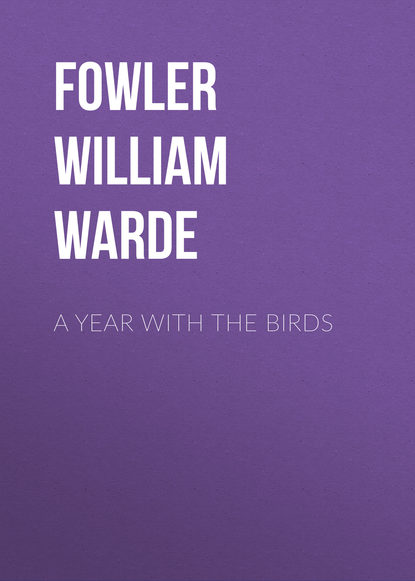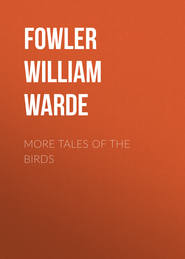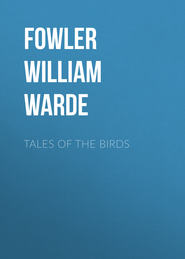По всем вопросам обращайтесь на: info@litportal.ru
(©) 2003-2024.
✖
A Year with the Birds
Настройки чтения
Размер шрифта
Высота строк
Поля
23
E.g. on the rocks about the Devil’s Bridge near Andermatt, or on these of the Gemmi-pass.
24
In common with other Woodpeckers, as Mr. H. Wharton has reminded me in the Academy. It is indeed very doubtful whether this striking bird was known either to Aristotle or Pliny; it is now an uncommon bird in Italy, and is properly an inhabitant of northern Europe. But when Italy was covered with forest (cp. Theophrastus, Hist. Plant, v. 8. 2) it must have been known to the country people.
25
The closer acquaintance has been made, and I have learnt the song of this bird, which is not unlike that of the Lesser White-throat described in Chapter II (#c2). Of all the warblers I know, this is the most restless and difficult to observe when once the leaves are fully out. It is the only bird, I think, which has completely baffled me during a whole morning spent in pursuing the song without once getting a fair look at the singer. (June, 1889.)
26
Mr. Seebohm’s British Birds is a remarkable exception to this tendency.
27
This kindly patron of birds is E. D. Lockwood, Esq., late of the Bengal Civil Service, and author of Natural History, Sport, and Travel in India.
28
They came, but found the hole occupied by the ubiquitous Starling. He again gave way to a pair of bold Blue-tits, who brought up their young here, flitting about the garden like large blue butterflies.
29
For exactly four years I saw no other Black Redstart in Oxfordshire. But on November 5, 1888, another caught my eye within half a mile of the spot described in the text. This time it was another new and ugly wall that he patronized, transferring his attention now and then to the cabbages in a cottage garden hard by.
30
The discovery in Germany (see the Ibis for April, 1889) of a Cuckoo hatching its own egg should put all English observers on the look-out. We have taken it too much for granted that such a thing could not happen.
31
Col. Barrow tells me that now (August, 1886) they have come to prefer bread to nuts, and will leave the latter so long as they can get the former.
32
When does he leave us? On Aug. 23, 1886, I saw an astonishing number of Flycatchers all on the same side of an orchard, and felt sure, from their restlessness, that they had assembled, as swallows do, in view of migration. On the 24th I went to S. Wales, where, during a whole week, I only saw one, though they were abundant up to that time. Letters from ornithological friends led me to believe that the birds have almost entirely disappeared from South and East England by about Sept. 12; and Mr. Seebohm is probably right in giving the first week of September as the usual date of their departure. How much less we know of the departure than of the arrival of birds, so quietly do they slip away!
33
Mr. Seebohm (Brit. Birds, i. 325) tells us of a quiet little warble, so low as to be scarcely heard at a few yards’ distance; but this I have never yet succeeded in catching.
34
This year (1886) I took all the sparrows’ nests on my house, and examined the young birds. Only one or two young peas and grains had been given them: they had been fed largely on insects.
35
Mr. Aplin tells me, however, that the upper parts, in summer at least, “have a decided wash or gloss of green”: Mr. Seebohm calls it “dull olive-brown.”
36
Stone-chats have been observed busy in this way near Oxford. – A. H. M.
37
The chat of the Whin-chat is a dissyllable, ‘u-tic’; that of the Stone-chat a monosyllable, ‘chat.’ (O. V. A.)
38
The Meadow Bunting (Emberiza cia) seemed to me, when I met with it in Switzerland this summer, to be more lively and restless than other Buntings.
39
See Note B (#pgepubid00007) at the end of the volume.
40
Or like a delicate electric bell, heard at some distance, while the door of your room is slowly opened and again closed.
41
Another cause is doubtless the crescendo and diminuendo which the bird uses: see a valuable note in The Birds of Cumberland, by the Rev. H. A. Macpherson and W. Duckworth.
42
In May this year (1886) I nearly trod upon a pair of these birds, near the same wood: yet they showed no fear, allowed me to approach them within six paces, and continued to reel close at hand.
43
As in Milton’s “most musical, most melancholy.” But as Coleridge remarks in a note to his own poem of the Nightingale, in Sibylline Leaves, these words of Milton are spoken in the character of the melancholy man, and have therefore a dramatic rather than a descriptive propriety. Coleridge’s own conception of the song is the true one and most happily expressed.
44
A Woodpecker on a railway bridge is a curiosity. But a Lesser Spotted bird was once seen on the stonework of the bridge which spans the Chipping Norton branch line, by the Rev. S. D. Lockwood, Rector of my parish, who knows the bird well.
45
Vol. ii. pp. 461-463. Hickwall seems to be the recognized orthography; but I spell the word as it was pronounced.
46
They will often build their nests in holes in the timber of the houses. Anderegg tells me that this was the case in his own house two years ago. Nor is this the only instance of the habits of birds being affected by the nature of the house-architecture in these parts; for the House-martins, being unable (I suppose) to make their nests adhere securely against timber, or disliking the large projecting eaves, build in the Haslithal under ledges of rock, and are known there as the Rock-martin, as distinct from the Rock-swallow (Felsenschwalbe), which is the name there given to the Crag-martin. It is well-known that there are places even in England where this bird prefers rocks to houses.
47
I afterwards saw three of the same species about some stunted thistles on the Furka-pass, at a height of 8000 feet, and on a bitter cold day. See Note D (#pgepubid00009). at end of Volume.
E.g. on the rocks about the Devil’s Bridge near Andermatt, or on these of the Gemmi-pass.
24
In common with other Woodpeckers, as Mr. H. Wharton has reminded me in the Academy. It is indeed very doubtful whether this striking bird was known either to Aristotle or Pliny; it is now an uncommon bird in Italy, and is properly an inhabitant of northern Europe. But when Italy was covered with forest (cp. Theophrastus, Hist. Plant, v. 8. 2) it must have been known to the country people.
25
The closer acquaintance has been made, and I have learnt the song of this bird, which is not unlike that of the Lesser White-throat described in Chapter II (#c2). Of all the warblers I know, this is the most restless and difficult to observe when once the leaves are fully out. It is the only bird, I think, which has completely baffled me during a whole morning spent in pursuing the song without once getting a fair look at the singer. (June, 1889.)
26
Mr. Seebohm’s British Birds is a remarkable exception to this tendency.
27
This kindly patron of birds is E. D. Lockwood, Esq., late of the Bengal Civil Service, and author of Natural History, Sport, and Travel in India.
28
They came, but found the hole occupied by the ubiquitous Starling. He again gave way to a pair of bold Blue-tits, who brought up their young here, flitting about the garden like large blue butterflies.
29
For exactly four years I saw no other Black Redstart in Oxfordshire. But on November 5, 1888, another caught my eye within half a mile of the spot described in the text. This time it was another new and ugly wall that he patronized, transferring his attention now and then to the cabbages in a cottage garden hard by.
30
The discovery in Germany (see the Ibis for April, 1889) of a Cuckoo hatching its own egg should put all English observers on the look-out. We have taken it too much for granted that such a thing could not happen.
31
Col. Barrow tells me that now (August, 1886) they have come to prefer bread to nuts, and will leave the latter so long as they can get the former.
32
When does he leave us? On Aug. 23, 1886, I saw an astonishing number of Flycatchers all on the same side of an orchard, and felt sure, from their restlessness, that they had assembled, as swallows do, in view of migration. On the 24th I went to S. Wales, where, during a whole week, I only saw one, though they were abundant up to that time. Letters from ornithological friends led me to believe that the birds have almost entirely disappeared from South and East England by about Sept. 12; and Mr. Seebohm is probably right in giving the first week of September as the usual date of their departure. How much less we know of the departure than of the arrival of birds, so quietly do they slip away!
33
Mr. Seebohm (Brit. Birds, i. 325) tells us of a quiet little warble, so low as to be scarcely heard at a few yards’ distance; but this I have never yet succeeded in catching.
34
This year (1886) I took all the sparrows’ nests on my house, and examined the young birds. Only one or two young peas and grains had been given them: they had been fed largely on insects.
35
Mr. Aplin tells me, however, that the upper parts, in summer at least, “have a decided wash or gloss of green”: Mr. Seebohm calls it “dull olive-brown.”
36
Stone-chats have been observed busy in this way near Oxford. – A. H. M.
37
The chat of the Whin-chat is a dissyllable, ‘u-tic’; that of the Stone-chat a monosyllable, ‘chat.’ (O. V. A.)
38
The Meadow Bunting (Emberiza cia) seemed to me, when I met with it in Switzerland this summer, to be more lively and restless than other Buntings.
39
See Note B (#pgepubid00007) at the end of the volume.
40
Or like a delicate electric bell, heard at some distance, while the door of your room is slowly opened and again closed.
41
Another cause is doubtless the crescendo and diminuendo which the bird uses: see a valuable note in The Birds of Cumberland, by the Rev. H. A. Macpherson and W. Duckworth.
42
In May this year (1886) I nearly trod upon a pair of these birds, near the same wood: yet they showed no fear, allowed me to approach them within six paces, and continued to reel close at hand.
43
As in Milton’s “most musical, most melancholy.” But as Coleridge remarks in a note to his own poem of the Nightingale, in Sibylline Leaves, these words of Milton are spoken in the character of the melancholy man, and have therefore a dramatic rather than a descriptive propriety. Coleridge’s own conception of the song is the true one and most happily expressed.
44
A Woodpecker on a railway bridge is a curiosity. But a Lesser Spotted bird was once seen on the stonework of the bridge which spans the Chipping Norton branch line, by the Rev. S. D. Lockwood, Rector of my parish, who knows the bird well.
45
Vol. ii. pp. 461-463. Hickwall seems to be the recognized orthography; but I spell the word as it was pronounced.
46
They will often build their nests in holes in the timber of the houses. Anderegg tells me that this was the case in his own house two years ago. Nor is this the only instance of the habits of birds being affected by the nature of the house-architecture in these parts; for the House-martins, being unable (I suppose) to make their nests adhere securely against timber, or disliking the large projecting eaves, build in the Haslithal under ledges of rock, and are known there as the Rock-martin, as distinct from the Rock-swallow (Felsenschwalbe), which is the name there given to the Crag-martin. It is well-known that there are places even in England where this bird prefers rocks to houses.
47
I afterwards saw three of the same species about some stunted thistles on the Furka-pass, at a height of 8000 feet, and on a bitter cold day. See Note D (#pgepubid00009). at end of Volume.







